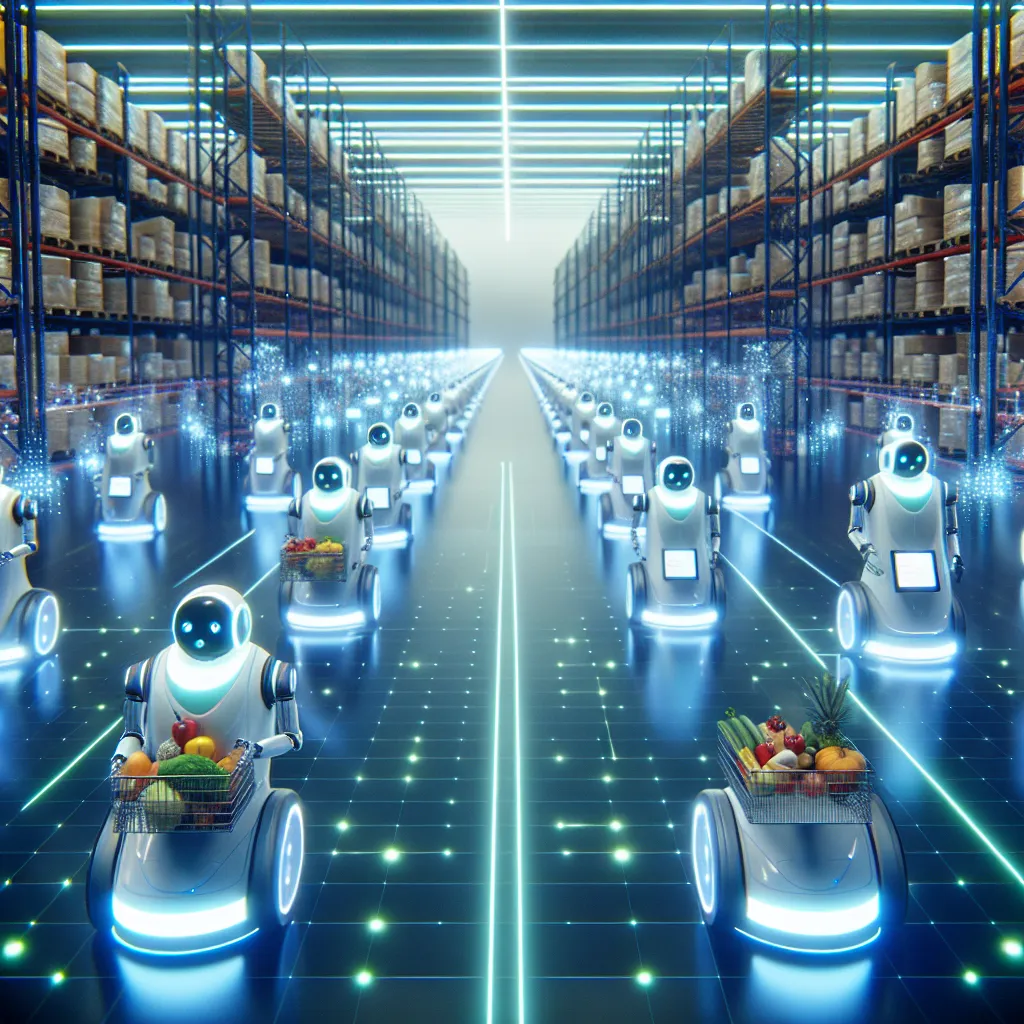Welcome to our IELTS Reading practice session focused on “The Role of AI in Reducing Food Waste.” This topic combines technology, sustainability, and global food security, making it an excellent subject for IELTS Reading comprehension. As an experienced IELTS instructor, I’ve crafted this practice test to closely resemble the actual IELTS Reading exam, complete with passages of varying difficulty and a range of question types.
Nội dung bài viết
- Introduction to the IELTS Reading Test
- Passage 1 (Easy Text)
- AI-Powered Solutions for Food Waste Reduction
- Questions 1-5
- Questions 6-10
- Passage 2 (Medium Text)
- The Intersection of AI and Sustainable Agriculture
- Questions 11-14
- Questions 15-19
- Question 20
- Passage 3 (Hard Text)
- The Multifaceted Impact of AI on Global Food Systems
- Questions 21-26
- Questions 27-32
- Questions 33-36
- Questions 37-40
- Answer Key
- Passage 1
- Passage 2
- Passage 3
 AI reducing food waste
AI reducing food waste
Introduction to the IELTS Reading Test
Before we dive into the practice test, let’s briefly review the structure of the IELTS Reading test:
- The test consists of three passages of increasing difficulty.
- You have 60 minutes to complete all three sections.
- There are 40 questions in total, testing various aspects of your reading comprehension.
- Question types include multiple choice, true/false/not given, matching information, and more.
Now, let’s begin with our practice test on “The Role of AI in Reducing Food Waste.”
Passage 1 (Easy Text)
AI-Powered Solutions for Food Waste Reduction
Food waste is a global issue with significant environmental and economic implications. According to the United Nations, approximately one-third of all food produced for human consumption is lost or wasted annually. This wastage not only squanders valuable resources but also contributes to greenhouse gas emissions. In recent years, artificial intelligence (AI) has emerged as a powerful tool in combating this problem.
AI technologies are being deployed across the food supply chain to optimize processes and reduce waste. For instance, predictive analytics algorithms can forecast demand more accurately, helping retailers to stock appropriate quantities and minimize surplus. These systems analyze historical sales data, weather patterns, and even social media trends to make precise predictions.
Another area where AI is making a difference is in quality control. Computer vision systems can rapidly inspect produce for signs of spoilage or damage, ensuring that only high-quality items reach consumers. This technology is particularly useful in sorting and grading fruits and vegetables, tasks that were traditionally labor-intensive and prone to human error.
Smart packaging is yet another innovation powered by AI. Sensors embedded in food containers can monitor conditions such as temperature and humidity, alerting distributors or consumers if the food is at risk of spoiling. Some advanced systems can even adjust the packaging environment to extend shelf life.
In the food service industry, AI-driven inventory management systems are helping restaurants and cafeterias reduce overproduction. These systems can learn from past consumption patterns and adjust portion sizes or menu offerings accordingly. Additionally, machine learning algorithms can analyze waste data to identify trends and suggest strategies for improvement.
While the implementation of AI in food waste reduction is still in its early stages, the potential impact is significant. As these technologies continue to evolve and become more widespread, we can expect to see substantial improvements in food conservation efforts worldwide.
Questions 1-5
Do the following statements agree with the information given in the passage?
Write:
TRUE if the statement agrees with the information
FALSE if the statement contradicts the information
NOT GIVEN if there is no information on this
- One-third of global food production is wasted or lost each year.
- AI can only be used in retail settings to reduce food waste.
- Computer vision systems are less accurate than human inspectors in quality control.
- Smart packaging can actively modify its internal environment to preserve food.
- AI-driven systems in restaurants can automatically change menu items based on consumption patterns.
Questions 6-10
Complete the sentences below.
Choose NO MORE THAN TWO WORDS from the passage for each answer.
- AI-powered __ __ can help retailers predict demand more accurately.
- Computer vision systems are particularly useful for __ and __ fruits and vegetables.
- __ in food packaging can monitor environmental conditions to prevent spoilage.
- In the food service industry, AI helps reduce __ by learning from past consumption patterns.
- The use of AI in food waste reduction is expected to lead to significant improvements in __ __ efforts globally.
Passage 2 (Medium Text)
The Intersection of AI and Sustainable Agriculture
The agricultural sector stands at a critical juncture, facing the dual challenges of meeting growing global food demand while simultaneously reducing its environmental footprint. Artificial Intelligence (AI) is emerging as a key player in this arena, offering innovative solutions that promise to revolutionize farming practices and contribute significantly to food waste reduction.
One of the most promising applications of AI in agriculture is precision farming. This approach utilizes a combination of sensors, drones, and satellite imagery to collect vast amounts of data about soil conditions, crop health, and weather patterns. AI algorithms then analyze this data to provide farmers with highly specific recommendations for resource allocation. For instance, smart irrigation systems can determine exactly when and how much water each section of a field needs, dramatically reducing water waste while optimizing crop yields.
AI is also transforming pest management strategies. Traditional methods often involve blanket applications of pesticides, which can be both ineffective and environmentally harmful. In contrast, AI-powered systems can identify pest infestations at an early stage and even predict outbreaks before they occur. This allows for targeted interventions, reducing the use of chemicals and minimizing crop losses.
In the realm of harvest optimization, AI is proving invaluable. Machine learning models can predict the optimal harvest time for different crops with remarkable accuracy. This precision ensures that produce is picked at peak ripeness, reducing the likelihood of spoilage during storage and transport. Moreover, robotic harvesting systems guided by AI can work around the clock, significantly reducing the amount of produce left to rot in fields due to labor shortages.
Post-harvest, AI continues to play a crucial role in reducing food waste. Advanced image recognition technology is being used to grade and sort produce more efficiently than ever before. This not only ensures that high-quality produce reaches consumers but also allows for the rapid identification of items suitable for alternative uses, such as processing into value-added products.
The potential of AI extends beyond the farm gate. In the supply chain, AI-driven logistics systems are optimizing transportation routes and storage conditions. These systems can adapt in real-time to changing conditions, ensuring that perishable goods reach their destination in the best possible state. Furthermore, blockchain technology integrated with AI is enhancing traceability, allowing for rapid identification and isolation of problematic batches, thus minimizing widespread waste in case of quality issues.
While the benefits of AI in sustainable agriculture are clear, challenges remain. The digital divide between large industrial farms and small-scale farmers poses a significant barrier to widespread adoption. Additionally, concerns about data privacy and the need for substantial initial investments are issues that need to be addressed.
Despite these challenges, the trajectory is clear: AI is set to play an increasingly important role in creating a more sustainable and efficient agricultural sector. As these technologies continue to evolve and become more accessible, we can anticipate a future where food waste is significantly reduced, resource use is optimized, and global food security is enhanced.
Questions 11-14
Choose the correct letter, A, B, C, or D.
-
According to the passage, precision farming uses AI to:
A) Completely automate all farming processes
B) Replace human farmers with robots
C) Provide specific recommendations for resource use
D) Increase the use of pesticides -
AI-powered pest management systems are superior to traditional methods because they:
A) Eliminate the need for any pesticide use
B) Can predict and identify pest problems early
C) Are cheaper to implement
D) Work faster than human farmers -
In harvest optimization, AI contributes by:
A) Completely replacing human labor
B) Only working during daylight hours
C) Predicting optimal harvest times accurately
D) Increasing the use of chemical ripening agents -
The integration of blockchain technology with AI in agriculture primarily aims to:
A) Create cryptocurrency for farmers
B) Replace traditional banking systems
C) Improve crop yields
D) Enhance traceability in the supply chain
Questions 15-19
Complete the summary below.
Choose NO MORE THAN TWO WORDS from the passage for each answer.
AI is revolutionizing agriculture through various applications. 15)__ __ uses data from sensors and satellites to provide specific farming recommendations. In pest management, AI allows for 16)__ __, reducing chemical use. For harvesting, 17)__ __ can predict the best time to pick crops, while robotic systems can harvest continuously. Post-harvest, 18)__ __ technology efficiently grades and sorts produce. In the supply chain, AI optimizes logistics and works with 19)__ __ to improve traceability.
Question 20
Choose the correct letter, A, B, C, or D.
- What is described as a major challenge for the widespread adoption of AI in agriculture?
A) Lack of effectiveness in reducing food waste
B) Resistance from environmental groups
C) The digital divide between large and small farms
D) Shortage of AI programmers in the agricultural sector
Passage 3 (Hard Text)
The Multifaceted Impact of AI on Global Food Systems
The integration of Artificial Intelligence (AI) into global food systems represents a paradigm shift in how we approach food production, distribution, and consumption. This technological revolution is not merely about incremental improvements; it’s about fundamentally reimagining our relationship with food and addressing some of the most pressing challenges facing humanity today.
At the heart of this transformation is the concept of data-driven agriculture. AI systems are capable of processing vast amounts of data from diverse sources – satellite imagery, IoT sensors, weather stations, and even social media – to create a holistic picture of the agricultural landscape. This comprehensive view allows for decision-making at a level of granularity and precision previously unimaginable. For instance, hyperspectral imaging combined with machine learning algorithms can detect plant stress or nutrient deficiencies long before they become visible to the human eye, enabling preemptive interventions that significantly reduce crop losses.
The implications of AI extend far beyond the farm. In the realm of supply chain management, AI is addressing one of the most persistent causes of food waste: inefficient distribution. Predictive analytics are being employed to forecast demand with unprecedented accuracy, allowing for just-in-time delivery systems that minimize storage times and reduce spoilage. Moreover, AI-powered routing algorithms are optimizing transportation networks, not only reducing fuel consumption and emissions but also ensuring that perishable goods reach their destinations in prime condition.
In retail environments, AI is revolutionizing inventory management and pricing strategies. Dynamic pricing models, informed by real-time data on stock levels, expiration dates, and consumer behavior, can adjust prices to encourage the sale of items approaching their best-before dates. This not only reduces waste but also potentially increases accessibility to nutritious food for price-sensitive consumers.
Perhaps one of the most exciting frontiers is the application of AI in food science and product development. Machine learning algorithms are being used to analyze flavor compounds and predict novel, appealing combinations. This capability is particularly valuable in the development of plant-based alternatives to animal products, a key strategy in reducing the environmental impact of food production. AI can rapidly iterate through thousands of potential formulations, dramatically accelerating the pace of innovation in this critical sector.
The potential of AI to address food insecurity on a global scale is profound. By optimizing production and minimizing waste, AI technologies could help to close the gap between global food production and nutritional needs. Precision agriculture guided by AI can increase yields while reducing input costs, making farming more viable in challenging environments. Furthermore, AI-driven early warning systems for crop failures or supply chain disruptions can enable more proactive and targeted interventions, potentially averting food crises before they occur.
However, the integration of AI into food systems is not without challenges and ethical considerations. The digital divide remains a significant barrier, with smallholder farmers in developing countries often lacking access to the technology and infrastructure necessary to benefit from these advancements. There are also valid concerns about data ownership and privacy, as the aggregation of agricultural data could potentially be misused or monopolized by large corporations.
Moreover, the reliance on AI systems raises questions about resilience and autonomy in food systems. While AI can enhance efficiency and productivity, overreliance on these systems could potentially create new vulnerabilities. A balanced approach that combines technological innovation with traditional agricultural knowledge and practices is likely to be most effective and sustainable.
The environmental implications of widespread AI adoption in agriculture are also complex. While AI can contribute to more sustainable farming practices, the energy consumption of data centers and the electronic waste generated by sensors and devices are factors that need to be carefully considered and mitigated.
As we navigate this technological frontier, it is crucial to approach the integration of AI into food systems with a holistic perspective. The goal should not merely be to optimize existing systems but to fundamentally reimagine them in ways that promote equity, sustainability, and resilience. This will require collaborative efforts across disciplines, sectors, and borders, as well as robust regulatory frameworks to ensure that the benefits of AI in food systems are widely and fairly distributed.
In conclusion, the role of AI in reducing food waste and transforming global food systems is both promising and complex. As these technologies continue to evolve, they offer unprecedented opportunities to address some of our most pressing food-related challenges. However, realizing this potential will require careful consideration of the ethical, social, and environmental implications, ensuring that the integration of AI into our food systems truly serves the broader goals of sustainability and global food security.
Questions 21-26
Complete the summary below.
Choose NO MORE THAN TWO WORDS from the passage for each answer.
AI is transforming global food systems through various applications. In agriculture, 21)__ __ allows for comprehensive decision-making by processing diverse data sources. Technologies like 22)__ __ can detect plant issues early. In supply chain management, 23)__ __ improve demand forecasting and delivery efficiency. Retail environments benefit from 24)__ __ models that adjust prices based on various factors. In food science, 25)__ __ analyze flavor compounds for product development. However, challenges remain, including the 26)__ __ which limits access to these technologies for some farmers.
Questions 27-32
Do the following statements agree with the claims of the writer in the passage?
Write:
YES if the statement agrees with the claims of the writer
NO if the statement contradicts the claims of the writer
NOT GIVEN if it is impossible to say what the writer thinks about this
- AI in agriculture can detect plant stress before it’s visible to humans.
- The use of AI in supply chain management always results in reduced food waste.
- Dynamic pricing models in retail can potentially make nutritious food more accessible to some consumers.
- AI-driven product development is mainly focused on creating plant-based alternatives to animal products.
- The integration of AI into food systems will solve global food insecurity within the next decade.
- There are concerns about data ownership and privacy in AI-driven agricultural systems.
Questions 33-36
Choose the correct letter, A, B, C, or D.
-
According to the passage, one of the main benefits of AI in addressing food insecurity is:
A) Completely eliminating the need for human farmers
B) Increasing yields while reducing input costs in challenging environments
C) Providing free food to all developing countries
D) Replacing traditional agricultural practices entirely -
The author suggests that the most effective approach to integrating AI in food systems is:
A) Relying entirely on AI and eliminating traditional methods
B) Rejecting AI in favor of purely organic farming
C) Combining AI innovation with traditional agricultural knowledge
D) Leaving the decision to individual farmers -
Regarding the environmental impact of AI in agriculture, the author:
A) Believes it will solve all environmental problems in farming
B) Suggests that the benefits clearly outweigh any potential drawbacks
C) Acknowledges that there are both positive and negative aspects to consider
D) Argues that the environmental costs are too high to justify its use -
The overall tone of the passage towards the role of AI in food systems can be described as:
A) Overwhelmingly enthusiastic without any reservations
B) Deeply skeptical and critical of all AI applications
C) Cautiously optimistic, acknowledging both potential and challenges
D) Neutral, presenting facts without any opinion
Questions 37-40
Complete the sentences below.
Choose NO MORE THAN THREE WORDS from the passage for each answer.
- AI-powered systems in agriculture can process data from various sources to create a __ __ of the agricultural landscape.
- In retail, AI can inform __ __ to encourage the sale of items nearing expiration.
- The application of AI in food science and product development is described as one of the most __ __.
- The author suggests that realizing the potential of AI in food systems requires careful consideration of __, __, and __ implications.
Answer Key
Passage 1
- TRUE
- FALSE
- NOT GIVEN
- TRUE
- TRUE
- predictive analytics
- sorting, grading
- Sensors
- overproduction
- food conservation
Passage 2
- C
- B
- C
- D
- Precision farming
- targeted interventions
- Machine learning
- image recognition
- blockchain technology
- C
Passage 3
- data-driven agriculture
- hyperspectral imaging
- Predictive analytics
- Dynamic pricing
- Machine learning algorithms
- digital divide
- YES
- NOT GIVEN
- YES
- NO
- NOT GIVEN
- YES
- B
- C
- C
- C


